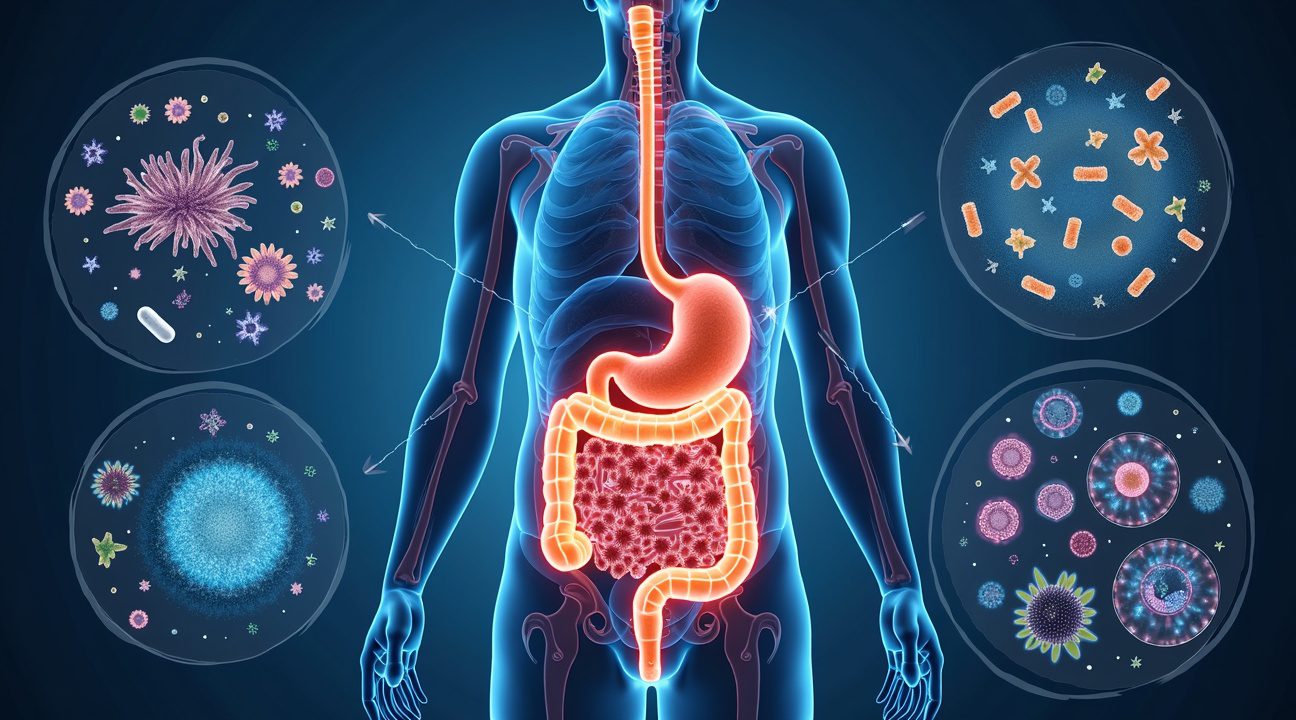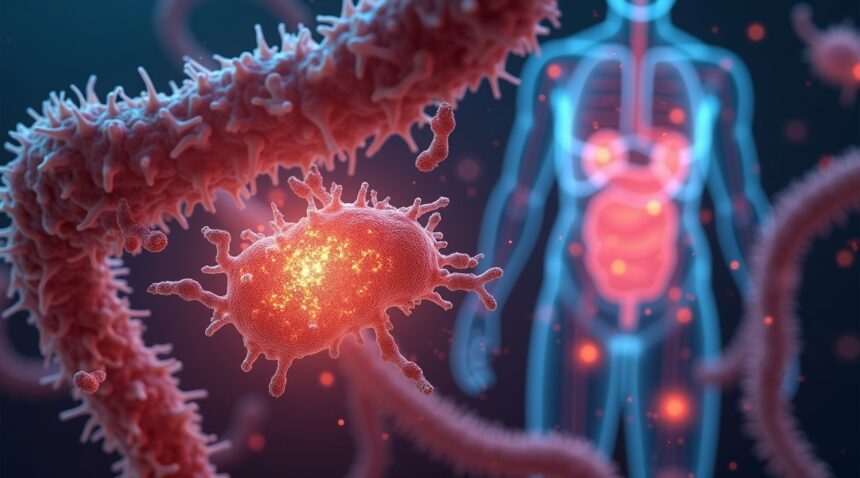Scientists have successfully developed genetically modified gut bacteria that can break down kidney stone-causing compounds directly inside the human body, representing a groundbreaking shift from symptom management to prevention at the source.
Engineered Gut Bacteria for Kidney Stone Prevention
The genetically modified Phocaeicola vulgatus bacteria specifically targets oxalate, a compound known to form painful crystal structures in the kidneys. By degrading oxalate in the digestive tract before it can be absorbed, this innovative approach prevents kidney stone formation at its root cause rather than managing symptoms post-occurrence.
How the Engineered Bacteria Works
The bacteria were engineered to carry genes that produce oxalate-degrading enzymes. When taken via a specially designed oral capsule that protects against stomach acid, the bacteria colonize the gut and begin breaking down oxalate almost immediately.
Porphyran-Based Safety Control
A unique safety mechanism is built into this therapy: the genetically modified bacteria require a dietary compound called porphyran, derived from seaweed, to survive. This provides a way to control the treatment:
- Therapeutic control – The bacteria only remain active when porphyran is consumed, allowing doctors and patients to precisely manage dosage.
- Reversibility – Ceasing porphyran intake eliminates the bacterial colony, halting treatment when needed.
Clinical Trial Successes and Challenges
Human clinical trials demonstrated promising safety outcomes, especially in patients suffering from enteric hyperoxaluria—a condition leading to frequent kidney stone formation due to high oxalate absorption.
- Effective colonization – Most participants showed successful bacterial colonization and oxalate degradation within days of a single oral dose.
- Minimal side effects – The treatment was generally well-tolerated throughout the study period.
- Long-term control issues – Four of the nineteen participants retained the bacteria even after stopping porphyran, pointing to challenges in complete strain elimination.
Broader Implications for Metabolic Disease Treatment
This approach is being explored beyond kidney stones. Other engineered bacteria are in development to treat:
- Phenylketonuria (PKU) – A genetic disorder affecting amino acid metabolism.
- Hyperammonemia – A condition marked by high ammonia levels in the blood.
- Other metabolic and genetic conditions – Future bacterial strains may be engineered to address multiple disorders simultaneously.
Advantages Over Traditional Medications
Engineered bacterial therapies offer several benefits:
- Continuous treatment – Bacteria maintain therapeutic enzyme levels without the need for frequent drug administration.
- Self-replication – A single dose can provide ongoing treatment when combined with controlled porphyran intake.
- Reduced manufacturing cost – Production scales up efficiently, potentially reducing cost compared to conventional drugs.
- Simplified distribution – These therapies may not require cold storage, improving accessibility worldwide.
Regulatory and Safety Considerations
As biological products, engineered bacterial therapies face a distinct regulatory pathway. Authorities require:
- Rigorous safety monitoring – Long-term studies to assess mutation risks and off-target colonization.
- Antibiotic resistance protocols – Ensuring the engineered strains resist common antibiotics without compromising biosafety.
The Future of Microbiome Medicine
Continued success in this area could accelerate innovation across multiple fields such as:
- Cancer immunotherapy
- Inflammatory disease treatments
- Nutrition-based therapeutics
Companies across the biotechnology space are competing to commercialize these therapies. If current trials proceed successfully, the kidney stone–targeting bacteria could reach clinical use within the next five years.
Economic and Societal Impact
Cost-effectiveness studies spotlight reduced reliance on surgeries and emergency interventions, potentially saving healthcare systems billions. Insurer decisions and public acceptance will critically determine uptake and accessibility.
This innovation represents a leap forward in precision medicine, targeting chronic conditions directly within the microbiome. As research evolves, personalized bacterial treatments may redefine modern medicine’s relationship with our microbial companions.
Genetically Modified Gut Bacteria Successfully Break Down Kidney Stone-Causing Compounds in Human Trials
Scientists have achieved a groundbreaking advancement in kidney stone prevention by genetically modifying a common gut bacterium to tackle the root cause of these painful formations. I’ve examined the research showing how Phocaeicola vulgatus has been engineered to break down oxalate, the compound responsible for most recurrent kidney stones.
Engineering Bacteria for Oxalate Degradation
The genetically engineered bacteria works by targeting oxalate before it can accumulate and form crystals in the kidneys. This microbial therapy approach represents a significant shift from traditional treatments that often focus on managing symptoms rather than preventing stone formation. Scientists modified Phocaeicola vulgatus specifically because this bacterium naturally thrives in the human gut environment and can be safely introduced without disrupting existing microbial communities.
Clinical testing progressed through carefully designed phases, starting with animal models before advancing to human volunteers. The research team first evaluated the therapy in healthy individuals to establish safety protocols, then expanded trials to include people with enteric hyperoxaluria (EH). This condition causes excessive oxalate absorption in the intestines, making these patients particularly susceptible to recurring kidney stones.
Human Trial Results and Safety Profile
Human trials demonstrated remarkable success with gut colonization achieved through a single oral dose when combined with proper gastric protection. The protective measures ensure the genetically engineered bacteria survive the acidic stomach environment and reach their target destination in the intestines. Once established, these modified microorganisms begin breaking down oxalate compounds before they can be absorbed into the bloodstream.
Safety monitoring revealed no serious adverse effects during the trial period. Perhaps more importantly, researchers found no significant changes in overall gut microbiome diversity, indicating the treatment doesn’t disrupt the delicate balance of beneficial bacteria already present. This finding addresses a major concern about introducing genetically modified organisms into the human body.
The therapy’s effectiveness in people with enteric hyperoxaluria proves particularly promising, as these patients often struggle with conventional treatments. Just as scientists think they’ve discovered mechanisms behind complex neurological phenomena, this research reveals how engineered microorganisms can address specific metabolic disorders.
These results suggest that genetically modified gut bacteria could offer a long-term solution for kidney stone prevention, potentially reducing the need for invasive procedures and providing relief for millions of people who suffer from recurrent stone formation.
How the Engineered Bacteria Work and Why Porphyran Makes Them Controllable
Scientists have created a remarkable bacterial strain that tackles kidney stones at their source through a sophisticated biological mechanism. The engineered bacteria function like microscopic recycling centers, equipped with a specialized transporter that efficiently captures oxalate from the digestive tract. Once inside the bacterial cells, an oxalate-metabolizing pathway converts this problematic compound into formate, effectively removing the primary building block that forms calcium oxalate kidney stones.
This conversion process represents a significant breakthrough because it addresses kidney stone formation before crystals can develop. Instead of allowing oxalate to accumulate and potentially crystallize in the kidneys, the bacteria intercept and neutralize it within the gut environment where it’s naturally processed.
The Porphyran Control System
The most innovative aspect of this treatment lies in its controllable nature through porphyran consumption. Researchers modified the bacteria to depend on porphyran, a unique nutrient derived from seaweed that’s rarely utilized by microbes in Western populations. Studies show that only about 2% of people naturally carry porphyran-utilizing bacterial strains in their gut microbiome, making this dependency mechanism particularly effective for therapeutic control.
This dependency creates several important advantages for treatment management:
- Colonization occurs only when porphyran is present in the diet
- Bacterial levels can be adjusted by modifying daily porphyran intake
- The therapeutic effect remains completely reversible
- Patients maintain full control over their treatment intensity
The engineering enables precise dosage control that wasn’t possible with previous bacterial therapies. Patients can increase porphyran consumption to boost bacterial colonization when kidney stone risk is higher, or reduce intake to dial back the treatment effect. This flexibility provides a level of personalized medicine that adapts to individual needs and circumstances.
Recent advances in biotechnology, including discoveries about brain mechanisms and life-building compounds, demonstrate how researchers continue pushing boundaries in biological engineering.
The porphyran control system also addresses safety concerns that have historically limited bacterial therapies. Unlike permanent genetic modifications or uncontrollable bacterial growth, this approach ensures that therapeutic bacteria remain dependent on dietary input. If patients need to discontinue treatment for any reason, they simply stop consuming porphyran-containing foods, and the engineered bacteria naturally clear from their system.
This level of control extends to treatment monitoring as well. Healthcare providers can track therapeutic effectiveness by measuring bacterial colonization levels, which directly correlate with porphyran intake. Blood and urine tests can confirm that oxalate levels are dropping as expected, providing clear feedback on treatment success.
The reversible nature of this therapy represents a paradigm shift in how doctors approach chronic conditions like kidney stones. Rather than relying on medications with potential side effects or invasive procedures, patients can manage their condition through controlled bacterial colonization that responds immediately to dietary changes.
Scientists designed this system specifically to overcome the unpredictability that has plagued previous bacterial treatments. The porphyran dependency ensures that therapeutic bacteria don’t establish permanent residence in the gut microbiome, preventing potential long-term complications while maintaining treatment effectiveness.
This engineering approach creates a treatment that’s both powerful and safe, giving patients unprecedented control over their kidney stone prevention strategy. The bacteria work continuously while present, processing oxalate around the clock, but their presence remains entirely optional based on patient choice and dietary habits.
Safety Results Show Promise Despite Some Persistent Colonization Issues
The removal of porphyran from participants’ diets successfully triggered elimination of the therapeutic bacterial strain in most cases, demonstrating the safety and reversibility of this engineered approach. This controlled elimination mechanism provides researchers with a crucial safeguard against unwanted long-term colonization of modified bacteria in the human gut.
However, persistent colonization occurred in 4 out of 19 subjects even after stopping porphyran supplementation. Scientists discovered that spontaneous genetic mutations or genome rearrangements allowed these bacterial strains to survive without their intended dietary trigger. This finding highlights critical concerns about strain stability that researchers must address before widespread clinical implementation.
Key Safety Challenges Identified
Long-term studies revealed several important safety considerations that require further investigation:
- Horizontal gene transfer between the therapeutic strain and native gut bacteria posed potential risks
- Loss of therapeutic function occurred in some bacterial populations over extended periods
- Competition with existing gut microbes affected the consistency of treatment outcomes
- Genome instability led to unpredictable bacterial behavior in certain participants
These findings underscore the complexity of introducing engineered organisms into the human microbiome. While the majority of subjects experienced successful strain elimination, the persistent colonization in roughly 21% of participants raises important questions about long-term safety protocols.
Researchers continue working to improve strain stability through enhanced genetic engineering techniques. The goal involves creating more predictable bacterial behavior while maintaining therapeutic effectiveness against kidney stones. Current efforts focus on developing stronger genetic controls that prevent unwanted mutations and ensure reliable elimination when treatment concludes.
The biosafety profile shows promise but requires additional refinement before this treatment can advance to larger clinical trials. Scientists must balance therapeutic benefits with potential risks of permanent gut microbiome alteration. Competition with native bacteria remains a significant hurdle that affects both safety and efficacy outcomes.
Despite these challenges, the reversible nature of the treatment in most participants represents a major safety milestone. The ability to eliminate therapeutic bacteria by simply removing porphyran from the diet provides doctors with an important control mechanism. This scientific breakthrough in bacterial engineering offers hope for treating kidney stones while maintaining acceptable safety standards for future patients.

How Gut Bacteria Naturally Influence Kidney Stone Formation
The delicate balance of microbial species within our digestive system plays a crucial role in determining whether kidney stones develop. I’ve observed through research that beneficial bacteria such as Lactobacillus actively work to inhibit stone formation by processing oxalate and other compounds before they can accumulate in the kidneys. Conversely, an overgrowth of E. coli creates conditions that promote stone development by altering the body’s ability to manage these problematic substances.
The Antibiotic Disruption Effect
Antibiotic overuse significantly disrupts the microbiome, creating an environment where kidney stone risk increases dramatically. These medications shift bacterial populations away from protective strains, leaving the body vulnerable to stone formation. I find it particularly concerning that many people don’t realize how scientists think they’ve discovered various connections between disrupted gut health and unexpected health consequences.
The disruption occurs because antibiotics can’t distinguish between harmful pathogens and beneficial bacteria. This indiscriminate approach eliminates crucial microorganisms that normally break down oxalate and other stone-forming compounds. Without these protective bacteria, dangerous metabolites accumulate and eventually crystallize in the kidneys.
Engineering Solutions for Prevention and Treatment
Researchers are now investigating how modifying both urinary tract and gut microbiota could prevent or treat various kidney diseases. The approach involves using engineered probiotics specifically designed to degrade stone-forming metabolites while maintaining overall microbial homeostasis.
These innovative treatments focus on several key mechanisms:
- Introducing bacteria that efficiently metabolize oxalate before it reaches the kidneys
- Restoring balance to disrupted microbiomes through targeted probiotic therapy
- Engineering microorganisms that can survive in harsh urinary environments
- Developing strains that produce enzymes specifically designed to break down problematic compounds
This research extends beyond kidney stones, with scientists exploring applications for other kidney-related conditions. The same principles that govern stone formation often apply to different types of kidney disease, making this a promising avenue for comprehensive treatment strategies.
Similar to how researchers have made breakthroughs in other areas – like when they found essential building blocks for life in unexpected places – these microbial discoveries are opening entirely new treatment possibilities. The precision required for engineering these therapeutic bacteria represents a significant advancement in personalized medicine, allowing treatments to target specific metabolic pathways while preserving beneficial microbial communities.

Similar Engineered Bacteria Therapies Target Other Metabolic Diseases
The kidney stone-fighting bacteria represents just one application of an emerging therapeutic approach that’s gaining traction across multiple metabolic disorders. Previous research efforts have demonstrated that engineered gut bacteria can serve as living metabolic filters, breaking down harmful compounds before they enter the bloodstream and cause systemic damage.
Scientists have already explored this concept with phenylketonuria (PKU), a genetic disorder where patients can’t properly process the amino acid phenylalanine. PKU affects approximately 1 in 10,000 to 15,000 newborns in the United States, and engineered bacterial strains have shown promise in degrading excess phenylalanine directly in the digestive tract. Similarly, researchers have investigated bacterial therapies for hyperammonemia, a condition characterized by dangerous ammonia buildup that can lead to brain damage.
Current Development Pipeline Shows Promise
Several companies are advancing engineered bacterial therapies through clinical trials, each targeting different metabolic pathways but sharing the same fundamental principle. Synlogic’s SYNB8802 employs specially modified bacteria designed to consume phenylalanine in PKU patients, while Novome’s NB1000 targets different metabolic compounds using alternative bacterial strains and dependency circuits.
These therapies face similar challenges that researchers encountered with the kidney stone treatment. Achieving efficient colonization remains difficult because engineered bacteria must compete with the existing gut microbiome for resources and space. Safety concerns also persist, as scientists must ensure these modified organisms don’t cause unintended consequences or develop resistance to their built-in control mechanisms.
The dependency circuits built into these bacterial strains represent a critical safety feature. These engineered limitations prevent the bacteria from surviving outside controlled laboratory conditions, much like how researchers develop containment systems for other experimental technologies. Without specific nutrients provided only in therapeutic formulations, the bacteria can’t reproduce or maintain themselves long-term.
What makes this approach particularly compelling is its potential to address diseases at their metabolic source rather than managing symptoms after damage occurs. Traditional treatments for metabolic disorders often require strict dietary restrictions or frequent medical interventions. Engineered bacteria could theoretically provide continuous, autonomous treatment that adapts to fluctuating levels of harmful compounds throughout the day.
The success of these various bacterial therapies will likely depend on overcoming the same fundamental hurdles:
- Ensuring stable gut colonization
- Maintaining therapeutic effectiveness over time
- Demonstrating long-term safety profiles
As researchers continue refining these living medicines, patients with metabolic disorders may soon have access to treatments that work around the clock, transforming how medicine approaches these challenging conditions.
Sources:
News Medical, “Microbial therapy uses modified bacteria to target oxalate in the gut”
Inside Precision Medicine, “Engineered Microbiome Therapy Improves Gut Colonization in Clinical Trials”
Medical Xpress, “Genetically modified gut bacteria show promise for combating kidney stones in clinical trial”
Cleveland Clinic, “First full characterization of kidney microbiome unlocks potential to prevent kidney stones”
Science Media Centre, “Gut bacteria engineered as a possible treatment for kidney stones”
W Wan et al., “Engineered microorganisms: A new direction in kidney stone prevention,” PMC10950756
“Therapeutic engineering of the gut microbiome using synthetic biology,” PMC12328466
Frontiers in Cellular and Infection Microbiology, “How is the human microbiome linked to kidney stones?”


